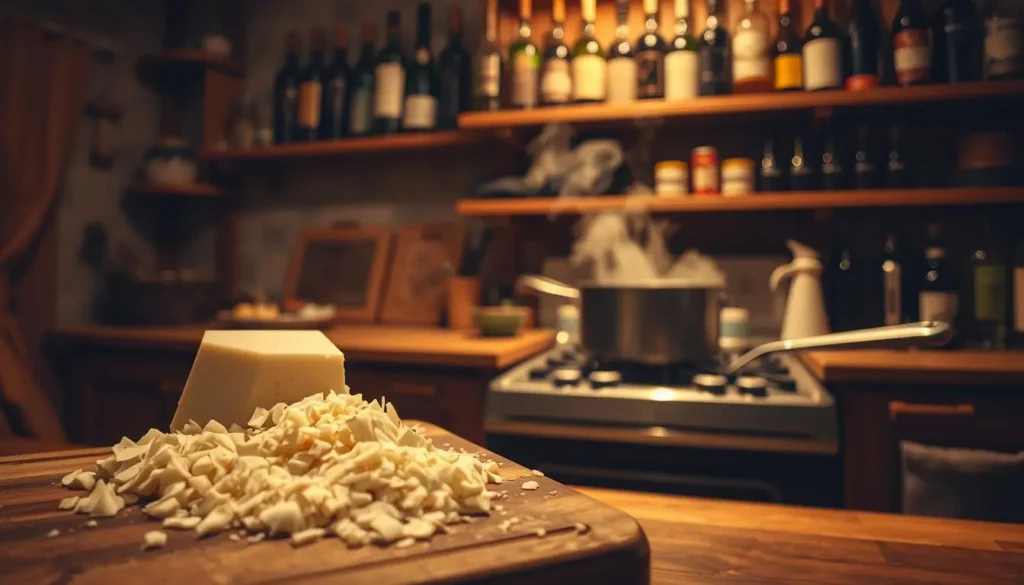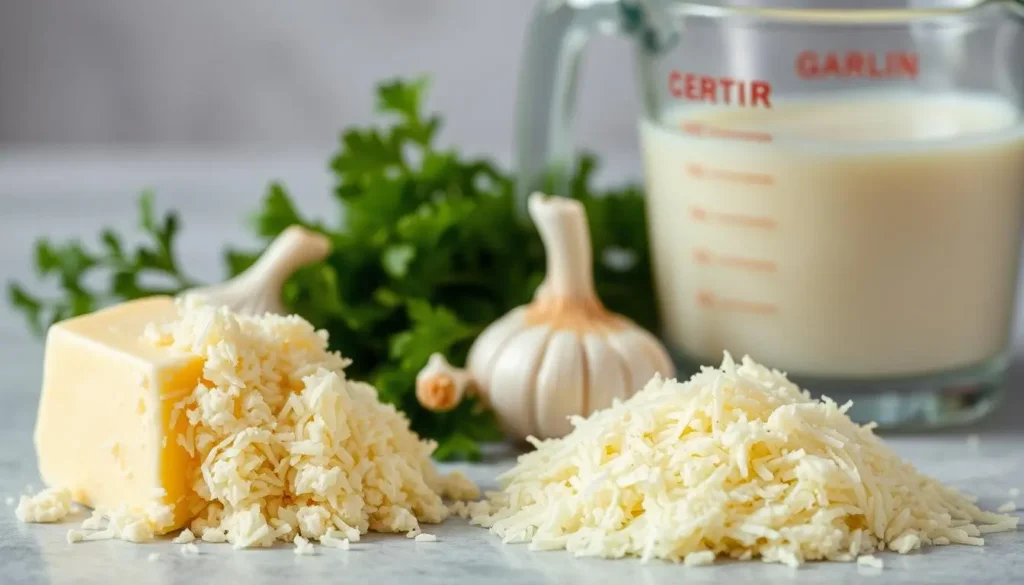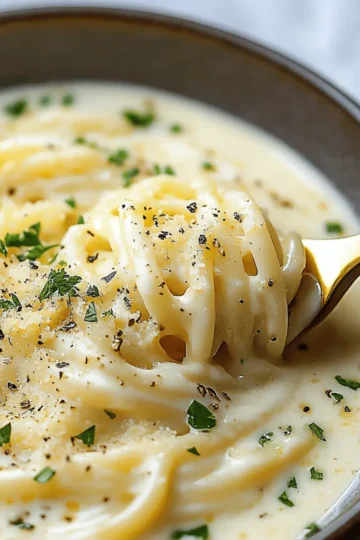Homemade Alfredo Sauce Recipe - Easy & Creamy
ADVERTISEMENT
A beautifully presented bowl of rich, creamy homemade Alfredo sauce, the perfect accompaniment to freshly cooked pasta. Silky, velvety sauce in the foreground, glistening with a glossy sheen, made with high-quality butter, heavy cream, and freshly grated Parmesan cheese. Delicate sprigs of fragrant basil leaves and a light dusting of freshly cracked black pepper in the middle ground, adding a vibrant pop of color and aroma. Warm, ambient lighting casts a soft, golden glow, creating a comforting and inviting atmosphere. Captured from a low, slightly angled perspective to highlight the luxurious texture and alluring creaminess of the Alfredo sauce, ready to be tossed with al dente pasta for a truly indulgent homemade dish.
Discover the ultimate homemade alfredo sauce recipe. It will make your pasta dishes amazing! With just a few simple ingredients, you can make a top-notch sauce at home.
ADVERTISEMENT
This classic alfredo sauce recipe is a game-changer. It's creamy, rich, and super easy to make. Our homemade alfredo sauce will be your favorite for quick, impressive meals.
Whether you're new to cooking or a pro, this guide will help you make the best alfredo sauce. You'll impress everyone with this simple yet luxurious sauce.
Get ready to learn the secrets of the perfect alfredo sauce. No complicated techniques needed! With just 15 minutes of prep and a few ingredients, you'll serve a creamy masterpiece that beats any restaurant's version.
What is Creamy Authentic Alfredo Sauce
Explore the world of authentic alfredo sauce, a true Italian treasure. It has a rich history that turns simple ingredients into a feast for the senses.

A cozy Italian kitchen, dimly lit with warm amber tones. In the foreground, a large wooden cutting board holds freshly chopped ingredients - garlic, Parmesan cheese, heavy cream, and butter. The middle ground features a saucepan simmering on a vintage stovetop, steam rising as the sauce comes together. In the background, shelves brimming with wine bottles, olive oil, and other classic Italian staples create an authentic ambiance. The scene is captured through a vintage lens, giving it a timeless, nostalgic feel that evokes the origins of the beloved Alfredo sauce.
Origins of Classic Alfredo Sauce
The classic alfredo sauce comes from Rome, Italy, in the early 1900s. Alfredo di Lelio made it for his pregnant wife. It was simple yet elegant, with just a few ingredients.
Traditional Ingredients Overview
- Freshly grated Parmesan cheese
- High-quality unsalted butter
- Salt and pepper
- Optional: Fresh pasta
"Simplicity is the ultimate sophistication" - This quote perfectly captures the essence of authentic alfredo sauce.
Modern Variations Explained
Traditional alfredo sauce is just butter and Parmesan. But today, people add:
- Heavy cream for extra richness
- Garlic for added depth
- Herbs like parsley or basil
- Protein options such as chicken or shrimp
Knowing how alfredo sauce has evolved shows its lasting charm. Whether you follow the original recipe or try new versions, you're part of a long tradition of delicious cooking.
Essential Ingredients for Perfect Alfredo Sauce

A neatly arranged still life of the essential ingredients for a classic creamy Alfredo sauce. In the foreground, a pile of freshly grated Parmesan cheese and a knob of rich, creamy butter. In the middle ground, a couple of garlic cloves, their skins partially peeled, alongside a bundle of fresh green parsley. The background features a glass measuring cup filled with warm, heavy cream, gently reflecting the soft, natural lighting. The overall mood is one of culinary elegance and mouthwatering anticipation, inviting the viewer to imagine the delicious sauce that will be created from these simple, high-quality ingredients.
Making authentic Alfredo sauce starts with picking the right ingredients. You'll learn how each part works together. This makes your pasta dishes creamy and delicious.
The key to a great Alfredo sauce is using fresh, quality ingredients. Here's what you need:
- Unsalted butter (4 tablespoons)
- Fresh garlic (4 cloves, finely minced)
- Heavy cream (1.5 cups, 38-40% fat content)
- Freshly grated Parmesan cheese (1.5 cups)
Each ingredient is important for the sauce's rich flavor and smooth texture. The quality of your ingredients affects the final taste.
*Pro tip: Always use freshly grated Parmesan cheese for the most authentic and robust flavor.*
Choosing the right ingredients can make a big difference. Use full-fat dairy for creaminess and flavor.
When picking your ingredients, focus on the cheese and cream. Parmesan should be finely grated. Heavy cream with high fat content makes the sauce velvety and irresistible.
Kitchen Tools and Equipment Needed
Making the perfect alfredo sauce is more than just using great ingredients. The right kitchen tools make the process smooth and fun. Let's look at the essential equipment for a delicious homemade alfredo sauce.
Must-Have Utensils for Alfredo Sauce Preparation
Some tools are essential when making alfredo sauce. Here are the must-haves for your kitchen:
- Medium-sized heavy-bottomed saucepan
- Sturdy whisk for smooth blending
- Wooden spoon or silicone spatula
- Measuring cups and spoons
- Cheese grater
Optional Helper Tools to Elevate Your Sauce
While not necessary, these tools can improve your alfredo sauce making:
- Microplane for fine cheese grating
- Immersion blender for extra smoothness
- Kitchen thermometer for precise temperature control
Choosing the Right Cookware
Your cookware is key for sauce making. A heavy-bottomed saucepan prevents scorching and ensures even heat. Stainless steel or enameled cast iron pans are best for creamy alfredo sauce.
Pro tip: Avoid aluminum pans, as they can interact with the dairy and affect the sauce's flavor and texture.
With these tools, you'll be ready to make a top-notch alfredo sauce in your kitchen.
Step-by-Step Alfredo Sauce Recipe
Making easy alfredo sauce is easier than you think! This simple recipe will make your home cooking shine with a creamy sauce. It's ready in just 10 minutes.
- Gather your ingredients:
- 3 tablespoons unsalted butter
- 1 cup heavy cream
- 4 minced garlic cloves
- 1½ cups freshly grated Parmesan cheese
- Salt and pepper to taste
- Melt the butter in a medium saucepan over medium-low heat
- Add minced garlic and sauté for 30-60 seconds until fragrant
- Pour in the heavy cream, stirring constantly
- Gradually whisk in Parmesan cheese until smooth
"The secret to a perfect easy alfredo sauce is patience and constant stirring!"
Pro tip: Keep the heat low to prevent separation. Your sauce should thicken in 5-8 minutes, coating the back of a spoon with a silky smooth texture. If it's too thick, add a bit of pasta water to get the right consistency.
This recipe makes about 2 cups of sauce, great for 8 ounces of fettuccine. Remember, low and slow is the key to creamy perfection!
Tips for Creating the Creamiest Texture
Making the perfect creamy alfredo sauce needs care and some special tricks. The sauce's texture can turn a simple meal into a fancy restaurant dish.
To get a silky smooth sauce, you must focus on a few important steps. Let's look at some expert tips to make your sauce truly stand out.
Temperature Control Techniques
Temperature is key for a creamy alfredo sauce. Here's what to do:
- Keep the heat low to medium
- Avoid boiling to prevent separation
- Stir constantly to avoid scorching
- Stop heating when the sauce is just right
Proper Cheese Integration
Cheese is the core of a creamy alfredo sauce. Chefs suggest:
- Use freshly grated Parmesan for better melting
- Add cheese slowly while stirring
- Grate cheese when it's at room temperature
- Use up to ½ cup of cheese per batch
"The secret to a perfect creamy alfredo sauce is patience and technique."
Consistency Adjustments
Learn to tweak the sauce's texture with these tips:
- For thicker sauce, add a tablespoon of cream cheese
- Thin it with milk or pasta water
- Use cornstarch for a gluten-free thickener
- Adjust the consistency before adding cheese
Creating the perfect creamy alfredo sauce takes time. Don't worry if it's not perfect the first time!
Common Mistakes to Avoid
Making the perfect alfredo sauce can be challenging, even for skilled cooks. Knowing the common mistakes helps you avoid them and achieve a smooth sauce.
Here are the key mistakes to watch out for:
- Cheese Selection Errors: Pre-grated Parmesan can make your sauce grainy. Grate fresh Parmigiano-Reggiano cheese from a block instead.
- Temperature Mismanagement: Overheating can cause the sauce to separate. Keep the heat low and steady.
- Improper Whisking: Constant whisking prevents lumps and keeps the sauce silky.
"The secret to a perfect alfredo sauce is patience and attention to detail." - Classic Italian Cooking Wisdom
To avoid these mistakes, follow these techniques:
- Use room temperature ingredients
- Warm cream gradually
- Remove from heat before sauce boils
- Whisk continuously while cooking
If your sauce breaks, don't worry. A quick fix is to remove it from heat, let it cool a bit, and whisk vigorously to mix it again.
Storage and Reheating Guidelines
Keeping your homemade Alfredo sauce fresh is key. You need to know how to store and reheat it right. This way, you can enjoy its creamy texture and rich taste for many meals.
Refrigeration and Storage Techniques
Here's how to store your Alfredo sauce:
- Use an airtight container for storage
- Refrigerate immediately after cooling
- Store for up to 3-4 days in the refrigerator
- Keep the sauce at a consistent temperature below 40°F
Effective Reheating Strategies
Reheating your Alfredo sauce needs gentle care. This keeps it creamy and smooth:
- Stovetop Method:
- Use low heat
- Stir frequently
- Add 1-2 tablespoons of milk to restore moisture
- Microwave Technique:
- Heat in 30-second intervals
- Stir between each interval
- Use 50% power to prevent overheating
Pro Tip: Always reheat your homemade Alfredo sauce slowly to preserve its silky texture and prevent breaking.
Freezing Your Alfredo Sauce
Freezing is great for longer storage. Freeze in portions for up to 3 months. Thaw slowly in the refrigerator and stir well before reheating.
Serving Suggestions and Pairings
Your homemade alfredo sauce recipe opens up a world of delicious culinary possibilities. The creamy, rich sauce pairs perfectly with numerous dishes. It transforms simple meals into gourmet experiences.
Classic pairings for your alfredo sauce recipe include:
- Fettuccine pasta (the traditional favorite)
- Grilled chicken breast
- Sautéed shrimp
- Roasted vegetables
For an exciting twist, try using your alfredo sauce in creative ways. Drizzle it over pizza, stuff it into chicken breasts, or use it as a decadent dipping sauce for breadsticks.
"A great alfredo sauce can elevate any dish from ordinary to extraordinary!" - Culinary Experts
When selecting side dishes, consider lighter options to balance the sauce's richness. A crisp green salad or steamed vegetables work wonderfully. For beverages, a light white wine like Pinot Grigio complements the creamy texture perfectly.
Pro tip: Experiment with different protein and vegetable combinations to discover your favorite alfredo sauce pairings. Your taste buds will thank you!
Nutritional Information and Dietary Considerations
Knowing about alfredo sauce nutrition helps you make better food choices. A typical serving of homemade Alfredo sauce has about 99 calories. This creamy sauce is tasty but should be eaten with care.
Here are the main nutrients in Alfredo sauce:
- Protein: 8 grams per serving
- Total fat: 4.7 grams
- Saturated fat: 3 grams
- Carbohydrates: 6.7 grams
The high fat in Alfredo sauce comes from butter and heavy cream. Experts say to enjoy it in.
"Eat wisely, but don't deprive yourself of culinary pleasures" - Nutrition Wisdom
If you're watching your diet, here are some tips:
- Choose low-fat dairy products
- Drink less of it
- Add veggies for more nutrients
- Try Greek yogurt instead of cream
Tip: Pair your Alfredo sauce with whole wheat pasta for more fiber and nutrients.
Conclusion
Your journey to make the perfect easy Alfredo sauce has been thrilling. You've learned about its Italian origins and how to mix ingredients just right. Now, you can make a sauce that will wow your loved ones.
The secret to a great Alfredo sauce is in how you make it. Keep your heat in check, whisk well, and use the best Parmesan and heavy cream. Your sauce will make any pasta dish special, whether it's fettuccine, penne, or spaghetti.
Feel free to add your own twist with chicken, mushrooms, or sun-dried tomatoes. Each change makes your sauce special and yours alone. With time, you'll get better at making a sauce that's as good as any restaurant's.
Now, you know that making amazing Alfredo sauce is easy for anyone. Keep trying, stay open to new ideas, and enjoy the tasty results of your cooking. Buon appetito!
FAQ
How long can I store homemade Alfredo sauce?
Homemade Alfredo sauce can last 3-4 days in the fridge. Cool it down first. Then, store it at 40°F or below to keep it fresh and safe.
Can I freeze Alfredo sauce?
Yes, you can freeze Alfredo sauce. But, it might change a bit when thawed. Freeze it in an airtight container for up to 2 months. When you reheat it, whisk well to get it creamy again. You might need to add a bit of cream or milk.
What are some dairy-free alternatives for Alfredo sauce?
For a dairy-free version, use cashew cream, nutritional yeast, and plant-based butter. You can also try coconut cream for a creamy base.
Why is my Alfredo sauce grainy or separated?
Grainy or separated sauce often comes from overheating or using pre-shredded cheese. Use fresh Parmesan and add cheese slowly over low heat. Whisk constantly. If it separates, whisk in a little warm milk or cream to fix it.
How can I make my Alfredo sauce lighter?
For a lighter version, use half-and-half instead of heavy cream. Reduce butter and add chicken broth. Try Greek yogurt or a mix of milk and cream to cut calories while keeping it creamy.
What pasta works best with Alfredo sauce?
Fettuccine is the best choice for Alfredo sauce. But, pappardelle works well too. Thicker pasta shapes help the sauce cling better. Avoid thin pasta like angel hair, as it gets overwhelmed by the sauce.
Can I add protein to my Alfredo sauce?
Yes! Add grilled chicken, shrimp, sautéed mushrooms, or crispy bacon. Vegetarian options include roasted broccoli, asparagus, or sun-dried tomatoes. They add flavor and nutrition.
What's the difference between traditional and American-style Alfredo sauce?
Traditional Italian Alfredo is just butter and Parmesan. It's lighter. American-style Alfredo has heavy cream, garlic, and sometimes cream cheese. It's richer and creamier.
How can I prevent my Alfredo sauce from becoming too thick?
If your sauce is too thick, thin it with warm milk, pasta water, or chicken broth. Add a little at a time and stir well. Always add liquid when the sauce is off the heat to avoid lumps.
Is Alfredo sauce gluten-free?
Traditional Alfredo sauce is gluten-free. But, check your ingredients, like pre-made cheese or seasonings. When making it from scratch, use gluten-free ingredients and be careful about cross-contamination.Homemade Alfredo Sauce Recipe - Easy & Creamy
A beautifully presented bowl of rich, creamy homemade Alfredo sauce, the perfect accompaniment to freshly cooked pasta. Silky, velvety sauce in the foreground, glistening with a glossy sheen, made with high-quality butter, heavy cream, and freshly grated Parmesan cheese. Delicate sprigs of fragrant basil leaves and a light dusting of freshly cracked black pepper in the middle ground, adding a vibrant pop of color and aroma. Warm, ambient lighting casts a soft, golden glow, creating a comforting and inviting atmosphere. Captured from a low, slightly angled perspective to highlight the luxurious texture and alluring creaminess of the Alfredo sauce, ready to be tossed with al dente pasta for a truly indulgent homemade dish.
Discover the ultimate homemade alfredo sauce recipe. It will make your pasta dishes amazing! With just a few simple ingredients, you can make a top-notch sauce at home.
This classic alfredo sauce recipe is a game-changer. It's creamy, rich, and super easy to make. Our homemade alfredo sauce will be your favorite for quick, impressive meals.
Whether you're new to cooking or a pro, this guide will help you make the best alfredo sauce. You'll impress everyone with this simple yet luxurious sauce.
Get ready to learn the secrets of the perfect alfredo sauce. No complicated techniques needed! With just 15 minutes of prep and a few ingredients, you'll serve a creamy masterpiece that beats any restaurant's version.
What is Authentic Alfredo Sauce
Explore the world of authentic alfredo sauce, a true Italian treasure. It has a rich history that turns simple ingredients into a feast for the senses.
A cozy Italian kitchen, dimly lit with warm amber tones. In the foreground, a large wooden cutting board holds freshly chopped ingredients - garlic, Parmesan cheese, heavy cream, and butter. The middle ground features a saucepan simmering on a vintage stovetop, steam rising as the sauce comes together. In the background, shelves brimming with wine bottles, olive oil, and other classic Italian staples create an authentic ambiance. The scene is captured through a vintage lens, giving it a timeless, nostalgic feel that evokes the origins of the beloved Alfredo sauce.
Origins of Classic Alfredo Sauce
The classic alfredo sauce comes from Rome, Italy, in the early 1900s. Alfredo di Lelio made it for his pregnant wife. It was simple yet elegant, with just a few ingredients.
Traditional Ingredients Overview
- Freshly grated Parmesan cheese
- High-quality unsalted butter
- Salt and pepper
- Optional: Fresh pasta
"Simplicity is the ultimate sophistication" - This quote perfectly captures the essence of authentic alfredo sauce.
Modern Variations Explained
Traditional alfredo sauce is just butter and Parmesan. But today, people add:
- Heavy cream for extra richness
- Garlic for added depth
- Herbs like parsley or basil
- Protein options such as chicken or shrimp
Knowing how alfredo sauce has evolved shows its lasting charm. Whether you follow the original recipe or try new versions, you're part of a long tradition of delicious cooking.
Essential Ingredients for Perfect Alfredo Sauce
A neatly arranged still life of the essential ingredients for a classic creamy Alfredo sauce. In the foreground, a pile of freshly grated Parmesan cheese and a knob of rich, creamy butter. In the middle ground, a couple of garlic cloves, their skins partially peeled, alongside a bundle of fresh green parsley. The background features a glass measuring cup filled with warm, heavy cream, gently reflecting the soft, natural lighting. The overall mood is one of culinary elegance and mouthwatering anticipation, inviting the viewer to imagine the delicious sauce that will be created from these simple, high-quality ingredients.
Making authentic Alfredo sauce starts with picking the right ingredients. You'll learn how each part works together. This makes your pasta dishes creamy and delicious.
The key to a great Alfredo sauce is using fresh, quality ingredients. Here's what you need:
- Unsalted butter (4 tablespoons)
- Fresh garlic (4 cloves, finely minced)
- Heavy cream (1.5 cups, 38-40% fat content)
- Freshly grated Parmesan cheese (1.5 cups)
Each ingredient is important for the sauce's rich flavor and smooth texture. The quality of your ingredients affects the final taste.
*Pro tip: Always use freshly grated Parmesan cheese for the most authentic and robust flavor.*
Choosing the right ingredients can make a big difference. Use full-fat dairy for creaminess and flavor.
When picking your ingredients, focus on the cheese and cream. Parmesan should be finely grated. Heavy cream with high fat content makes the sauce velvety and irresistible.
Kitchen Tools and Equipment Needed
Making the perfect alfredo sauce is more than just using great ingredients. The right kitchen tools make the process smooth and fun. Let's look at the essential equipment for a delicious homemade alfredo sauce.
Must-Have Utensils for Alfredo Sauce Preparation
Some tools are essential when making alfredo sauce. Here are the must-haves for your kitchen:
- Medium-sized heavy-bottomed saucepan
- Sturdy whisk for smooth blending
- Wooden spoon or silicone spatula
- Measuring cups and spoons
- Cheese grater
Optional Helper Tools to Elevate Your Sauce
While not necessary, these tools can improve your alfredo sauce making:
- Microplane for fine cheese grating
- Immersion blender for extra smoothness
- Kitchen thermometer for precise temperature control
Choosing the Right Cookware
Your cookware is key for sauce making. A heavy-bottomed saucepan prevents scorching and ensures even heat. Stainless steel or enameled cast iron pans are best for creamy alfredo sauce.
Pro tip: Avoid aluminum pans, as they can interact with the dairy and affect the sauce's flavor and texture.
With these tools, you'll be ready to make a top-notch alfredo sauce in your kitchen.
Step-by-Step Alfredo Sauce Recipe
Making easy alfredo sauce is easier than you think! This simple recipe will make your home cooking shine with a creamy sauce. It's ready in just 10 minutes.
- Gather your ingredients:
- 3 tablespoons unsalted butter
- 1 cup heavy cream
- 4 minced garlic cloves
- 1½ cups freshly grated Parmesan cheese
- Salt and pepper to taste
- Melt the butter in a medium saucepan over medium-low heat
- Add minced garlic and sauté for 30-60 seconds until fragrant
- Pour in the heavy cream, stirring constantly
- Gradually whisk in Parmesan cheese until smooth
"The secret to a perfect easy alfredo sauce is patience and constant stirring!"
Pro tip: Keep the heat low to prevent separation. Your sauce should thicken in 5-8 minutes, coating the back of a spoon with a silky smooth texture. If it's too thick, add a bit of pasta water to get the right consistency.
This recipe makes about 2 cups of sauce, great for 8 ounces of fettuccine. Remember, low and slow is the key to creamy perfection!
Tips for Creating the Creamiest Texture
Making the perfect creamy alfredo sauce needs care and some special tricks. The sauce's texture can turn a simple meal into a fancy restaurant dish.
To get a silky smooth sauce, you must focus on a few important steps. Let's look at some expert tips to make your sauce truly stand out.
Temperature Control Techniques
Temperature is key for a creamy alfredo sauce. Here's what to do:
- Keep the heat low to medium
- Avoid boiling to prevent separation
- Stir constantly to avoid scorching
- Stop heating when the sauce is just right
Proper Cheese Integration
Cheese is the core of a creamy alfredo sauce. Chefs suggest:
- Use freshly grated Parmesan for better melting
- Add cheese slowly while stirring
- Grate cheese when it's at room temperature
- Use up to ½ cup of cheese per batch
"The secret to a perfect creamy alfredo sauce is patience and technique."
Consistency Adjustments
Learn to tweak the sauce's texture with these tips:
- For thicker sauce, add a tablespoon of cream cheese
- Thin it with milk or pasta water
- Use cornstarch for a gluten-free thickener
- Adjust the consistency before adding cheese
Creating the perfect creamy alfredo sauce takes time. Don't worry if it's not perfect the first time!
Common Mistakes to Avoid
Making the perfect alfredo sauce can be challenging, even for skilled cooks. Knowing the common mistakes helps you avoid them and achieve a smooth sauce.
Here are the key mistakes to watch out for:
- Cheese Selection Errors: Pre-grated Parmesan can make your sauce grainy. Grate fresh Parmigiano-Reggiano cheese from a block instead.
- Temperature Mismanagement: Overheating can cause the sauce to separate. Keep the heat low and steady.
- Improper Whisking: Constant whisking prevents lumps and keeps the sauce silky.
"The secret to a perfect alfredo sauce is patience and attention to detail." - Classic Italian Cooking Wisdom
To avoid these mistakes, follow these techniques:
- Use room temperature ingredients
- Warm cream gradually
- Remove from heat before sauce boils
- Whisk continuously while cooking
If your sauce breaks, don't worry. A quick fix is to remove it from heat, let it cool a bit, and whisk vigorously to mix it again.
Storage and Reheating Guidelines
Keeping your homemade Alfredo sauce fresh is key. You need to know how to store and reheat it right. This way, you can enjoy its creamy texture and rich taste for many meals.
Refrigeration and Storage Techniques
Here's how to store your Alfredo sauce:
- Use an airtight container for storage
- Refrigerate immediately after cooling
- Store for up to 3-4 days in the refrigerator
- Keep the sauce at a consistent temperature below 40°F
Effective Reheating Strategies
Reheating your Alfredo sauce needs gentle care. This keeps it creamy and smooth:
- Stovetop Method:
- Use low heat
- Stir frequently
- Add 1-2 tablespoons of milk to restore moisture
- Microwave Technique:
- Heat in 30-second intervals
- Stir between each interval
- Use 50% power to prevent overheating
Pro Tip: Always reheat your homemade Alfredo sauce slowly to preserve its silky texture and prevent breaking.
Freezing Your Alfredo Sauce
Freezing is great for longer storage. Freeze in portions for up to 3 months. Thaw slowly in the refrigerator and stir well before reheating.
Serving Suggestions and Pairings
Your homemade alfredo sauce recipe opens up a world of delicious culinary possibilities. The creamy, rich sauce pairs perfectly with numerous dishes. It transforms simple meals into gourmet experiences.
Classic pairings for your alfredo sauce recipe include:
- Fettuccine pasta (the traditional favorite)
- Grilled chicken breast
- Sautéed shrimp
- Roasted vegetables
For an exciting twist, try using your alfredo sauce in creative ways. Drizzle it over pizza, stuff it into chicken breasts, or use it as a decadent dipping sauce for breadsticks.
"A great alfredo sauce can elevate any dish from ordinary to extraordinary!" - Culinary Experts
When selecting side dishes, consider lighter options to balance the sauce's richness. A crisp green salad or steamed vegetables work wonderfully. For beverages, a light white wine like Pinot Grigio complements the creamy texture perfectly.
Pro tip: Experiment with different protein and vegetable combinations to discover your favorite alfredo sauce pairings. Your taste buds will thank you!
Nutritional Information and Dietary Considerations
Knowing about alfredo sauce nutrition helps you make better food choices. A typical serving of homemade Alfredo sauce has about 99 calories. This creamy sauce is tasty but should be eaten with care.
Here are the main nutrients in Alfredo sauce:
- Protein: 8 grams per serving
- Total fat: 4.7 grams
- Saturated fat: 3 grams
- Carbohydrates: 6.7 grams
The high fat in Alfredo sauce comes from butter and heavy cream. Experts say to enjoy it in.
"Eat wisely, but don't deprive yourself of culinary pleasures" - Nutrition Wisdom
If you're watching your diet, here are some tips:
- Choose low-fat dairy products
- Drink less of it
- Add veggies for more nutrients
- Try Greek yogurt instead of cream
Tip: Pair your Alfredo sauce with whole wheat pasta for more fiber and nutrients.
Conclusion
Your journey to make the perfect easy Alfredo sauce has been thrilling. You've learned about its Italian origins and how to mix ingredients just right. Now, you can make a sauce that will wow your loved ones.
The secret to a great Alfredo sauce is in how you make it. Keep your heat in check, whisk well, and use the best Parmesan and heavy cream. Your sauce will make any pasta dish special, whether it's fettuccine, penne, or spaghetti.
Feel free to add your own twist with chicken, mushrooms, or sun-dried tomatoes. Each change makes your sauce special and yours alone. With time, you'll get better at making a sauce that's as good as any restaurant's.
Now, you know that making amazing Alfredo sauce is easy for anyone. Keep trying, stay open to new ideas, and enjoy the tasty results of your cooking. Buon appetito!
FAQ
How long can I store homemade Alfredo sauce?
Homemade Alfredo sauce can last 3-4 days in the fridge. Cool it down first. Then, store it at 40°F or below to keep it fresh and safe.
Can I freeze Alfredo sauce?
Yes, you can freeze Alfredo sauce. But, it might change a bit when thawed. Freeze it in an airtight container for up to 2 months. When you reheat it, whisk well to get it creamy again. You might need to add a bit of cream or milk.
What are some dairy-free alternatives for Alfredo sauce?
For a dairy-free version, use cashew cream, nutritional yeast, and plant-based butter. You can also try coconut cream for a creamy base.
Why is my Alfredo sauce grainy or separated?
Grainy or separated sauce often comes from overheating or using pre-shredded cheese. Use fresh Parmesan and add cheese slowly over low heat. Whisk constantly. If it separates, whisk in a little warm milk or cream to fix it.
How can I make my Alfredo sauce lighter?
For a lighter version, use half-and-half instead of heavy cream. Reduce butter and add chicken broth. Try Greek yogurt or a mix of milk and cream to cut calories while keeping it creamy.
What pasta works best with Alfredo sauce?
Fettuccine is the best choice for Alfredo sauce. But, pappardelle works well too. Thicker pasta shapes help the sauce cling better. Avoid thin pasta like angel hair, as it gets overwhelmed by the sauce.
Can I add protein to my Alfredo sauce?
Yes! Add grilled chicken, shrimp, sautéed mushrooms, or crispy bacon. Vegetarian options include roasted broccoli, asparagus, or sun-dried tomatoes. They add flavor and nutrition.
What's the difference between traditional and American-style Alfredo sauce?
Traditional Italian Alfredo is just butter and Parmesan. It's lighter. American-style Alfredo has heavy cream, garlic, and sometimes cream cheese. It's richer and creamier.
How can I prevent my Alfredo sauce from becoming too thick?
If your sauce is too thick, thin it with warm milk, pasta water, or chicken broth. Add a little at a time and stir well. Always add liquid when the sauce is off the heat to avoid lumps.
Is Alfredo sauce gluten-free?
Traditional Alfredo sauce is gluten-free. But, check your ingredients, like pre-made cheese or seasonings. When making it from scratch, use gluten-free ingredients and be careful about cross-contamination.





Leave a Reply